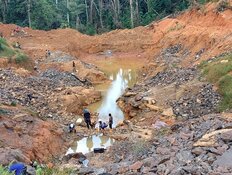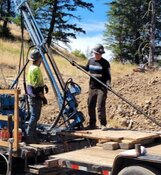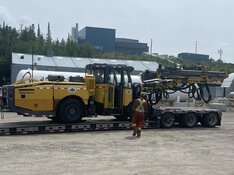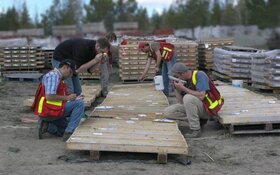Paolo Lostritto: There's a fair value calculation that we use. We take total reserves globally and divide by what we think is total on surface. It's a guesstimate, not an exact science. The fair value we're at right now is about $1,200. That being said, this is with a backdrop of quantitative easing; governments keeping accommodative monetary policy in place in order to try and kick-start a stagnant economy. So it suggests to us, even though we're at the fair value number right now, that the fair value has a bias towards going higher going forward. Short term, the risks in terms of the actual gold price going lower are tied to this whole issue with Greece and whether or not that can be settled. In fact, if they cannot settle the debt issues over in Europe, that's in fact deflationary and this could be negative for gold in the short term. However, longer term we're very bullish.
TGR: We are seeing, because of those debt issues in Greece, some investors are moving out of the euro and other currencies, including the U.S. dollar, and going into gold. Are people going to continue to replace their investments in the euro and other currencies with investments in gold?
PL: That has been happening recently. You're seeing the euro gold price hit all-time highs in the last couple of days. What in fact is happening is you're seeing gold running in U.S. dollars while the U.S. dollar is strengthening. So that decoupling is a sign that you're seeing a flight out of the euro into both gold and the U.S. dollar. Also the Swiss franc has been very strong over the course of the last couple of days. There's definitely a flight out of the euro zone. The thing that people should be cognizant of is the reason why Greece is in the predicament it's in. It's because of the amount of debt that it has and its inability to service that debt. It's probably worth noting that maybe some of these safe havens (i.e., the U.S. dollar) may be facing the same issues going forward. That is part of the reason why gold is of particular interest during this cycle.
TGR: In addition to that impacting the demand for gold, we're seeing increased consumer demand for gold in India and China. Do you see that continuing to impact demand?
PL: The physical demand in India has actually been quite stagnant over the last year and a bit. That's a function of the jewelry market in India that is very price sensitive. Traditionally the Indians have been a large consumer of gold from a jewelry perspective and very price sensitive as a result. The reason why they've been price sensitive over the course of the last year or so has been best described by Pierre Lassonde. He was quoted as saying that the investment community right now is effectively setting the price at a level where the jewelry demand is not as aggressive. The reason for it is the jewelry market is a price taker, whereas the investment community is a price setter. That's part of the reason why you've seen India step back. However, on the other side of the coin, China seems to be growing in terms of investment demand. World gold counts recently suggested that the demand out of China is set to double over the course of the next decade, which has positive implications in terms of the supply/demand dynamic.
TGR: What's driving that increased demand in China?
PL: Well, it's real wealth creation. Overall in Asia, there is a view that precious metals are a great form of protecting your savings. So it's a cultural thing. In addition to that, it's a form of diversification of wealth. As people in China, and in Asia in general, improve their way of life, there's a natural migration of some of that wealth going to savings in different currencies but also in gold.
TGR: What about the effect of inflation? We keep hearing that word tossed around. What's your take on whether or not we're going to see inflation and how is that going to affect demand in price for gold?
PL: Inflation, as most people remember it in North America, was created during the 1970s when it was a labor inflation issue. Right now inflation in the U.S., Canada and Europe is not an issue but it can quickly become one. There's been a lot of money supply that's been created, but the velocity of money, or the multiplier effect, has been very low. The reason for that is just a function of all this money being created, just sitting on tier one balance sheets. It's not being levered up at all through the system. Where the inflation seems to be happening right now is in Asia and the commodities emerging nations are consuming. To some degree, inflation appears to be exported to western countries. However, if the multiplier or velocity starts to pick up, watch out.
TGR: With the attention that gold is getting again, do you see that affecting the other precious metals or even the base metals?
PL: It's always been said that silver is the poor man's gold. However, there's a larger industrial component to the silver market. So there is a relationship between silver and gold, but you have to be cognizant that the industrial demand component has to be there as well. We're starting to see the early signs that silver is catching up a bit and the gold/silver ratio is starting to return to levels that would be considered more traditional. As for base metals in an inflationary environment, base metals also act as a hedge against inflation. So there is some correlation between gold price movement and base metal movement. It is worth noting that there are very few primary silver mines out there and that most silver production is a by-product from a base metal deposit.
TGR: In March, Kinross Gold Corp. (TSX:K;NYSE:KGC) acquired Underworld Resources Ltd. (TSX.V:UW) for its gold deposit in the Yukon. You commented that the Underworld discovery brings attention to Yukon projects with good metallurgy. You pointed to Victoria Gold Corp. (TSX.V:VIT), ATAC Resources Ltd. (TSX.V:ATC) and Golden Predator Royalty & Development Corp. (TSX:GPD) as companies with projects that fit the bill. Now were you suggesting in that comment that these companies will become acquisition candidates?
PL: Well, they're companies that we believe are doing good work in that part of the world. However, Underworld was much more advanced, relative to some of the ones you've just mentioned. The reason the Yukon is gaining attention again is that you have a government in place that is mining-friendly. It has told these exploration companies and these mining companies that they're open for business and have put policies in place such that it's attracting capital for exploration and mine development. So that's why it's caught a bit of a bid in market attention.
Another place that's very much the same is Burkina Faso. In terms of their rule of law, the policies that have been put in place in order to attract capital resulted in IAMGOLD Corp. (TSX:IMG;NYSE:IAG) going in and developing Essakane. A number of smaller juniors are going in and exploring and having success. As a result, IAMGOLD's stock price is gaining a lot of attention because the market is recognizing that there's that opportunity there. It's worth noting that operating in the Yukon is a little bit more expensive than maybe some other places because it is further north. It's a bit more remote. What is changing is that there's a lot more infrastructure that's being invested in by the Yukon government this time around in the form of roads and power lines. That is also attracting capital.
TGR: So is it still difficult though to get the product out of the Yukon at this point?
PL: Well, we have yet to see full-blown mining operations come on stream in the Yukon. There have been a few concepts out there and some historic production. We have yet to see modern confirmation that profitable production can be achieved, but it's moving in the right direction. The same with Burkina Faso. We've got Essakane—that should be commercial by August of this year.
TGR: Are there any geopolitical issues involved with Burkina Faso?
PL: Anytime you're dealing with West Africa, it has its challenges. However, in Africa, things seem to move a little bit slowly. In terms of taxation, in terms of rule of law, in terms of willingness to accept foreign investment and allow companies to come in and act responsibly and develop those assets within the country, we're seeing some good early signs as demonstrated by the fact that we've had IAMGOLD develop Essakane. You've seen a company like Volta Resources (TSX:VTR) move forward with their Kiaka project. You've seen an Australian company called Ampella with their success there. Definitely Burkina is catching people's attention.
TGR: When you're looking at gold companies, are you looking primarily at companies that are involved in exploration or production?
PL: My background is engineering, so I like looking at companies from a production standpoint. However, that being said, our bread and butter here at Wellington is to focus on companies that have enough information that we can envision where they are going and grow with that company as they develop the asset and move toward production. An example of that is a company like Lake Shore Gold Corp. (TSX:LSG), which we've covered since it was at a $50 million market cap. It's currently a billion dollar market cap. I think it's just getting started.
TGR: What are the criteria that you look at when you're trying to make a decision on investing in a particular company?
PL: First and foremost are the people. Then after that we start looking at the asset. The asset has to have scale and a certain level of quality that would attract capital from the institutional clients that we service.
TGR: How much of an impact does the geographical location of that company have on your decision?
PL: Quite a bit, actually. I've made it a focus to concentrate on companies mostly in North America, although I've taken a bit of a shine to West Africa as of late. The current global political environment is such that North America, especially Canada, is going to benefit from a relative risk performance perspective.
TGR: How would you compare the Yukon to the Burkina Faso area in terms of potential major finds?
PL: They both have the potential of yielding really large assets. Politically, I would give a slight edge to the Yukon because you're dealing with a first world nation that understands rule of law a little bit more maybe than West Africa. However, that being said, things can happen a lot cheaper in West Africa than they can in the Yukon, just from a logistics and infrastructure standpoint. There are challenges in both areas. Power is an issue in both areas, but it looks like the Yukon is trying to address that. In addition to that, the World Bank looks to be putting quite a few major power lines in West Africa that will help develop some of these remote assets.
TGR: As you're looking to balance your portfolio, and looking at growing with certain companies and regions, are they equally attractive as an investor? The fact that you get cheaper cost of gold out of West Africa seems to be a darn good asset as an investor. How do you compare the two?
PL: Well, what you have is a function of the assets themselves, right? So let's compare Victoria versus Volta. With Volta I've got an asset that's growing quite substantially and there's a certain cost space, a certain discount rate that I'm applying to it to account for the risk. Then you look at Victoria and that's also a growing asset with good cost space and should benefit from the fact that it's growing as well. However, each project has to be valued according to its merits. So you can't just make a blanket statement and look at just a region and say I like this one over the other one. They're pretty much similar. They both have advantages and disadvantages. Then you've just got to dig into the nitty-gritty for each.
TGR: In addition to your interest in the Yukon, are there other areas around North America that you find interesting in terms of gold?
PL: Definitely in South Carolina. The first gold recorded in North America was by Thomas Jefferson in West Virginia, I do believe. A lot of the gold mining that happened in the U.S. was originally in South Carolina. In fact, the location of the second U.S. Mint was in Charlotte. The reason why there are so many banking centers in Charlotte is the function of gold mines that were in and around that area. However, in the late 1800s there was a gold rush to Arizona and California because you were dealing with less overburden. Everybody forgot about all the gold that was in South Carolina. It has a bit of a rebirth as a function of the success that Romarco Minerals Inc. (TSX.V:R) had in that camp. It is complex geology and it takes a little bit more work to coax out the secrets, but it is interesting in terms of a district that is politically motivated to allow people to go out and do their thing.
TGR: Is Romarco producing?
PL: No. They have a feasibility study out. The idea is that they're going to put out an updated feasibility study at the end of June of this year. There could be a little bit of slippage on that because they keep finding more gold, but the idea is that they are moving towards production. We have them estimated to start production second half of 2012.
TGR: In addition to gold, are you watching other precious metals? Is there anything that interests you there?
PL: We cover one silver company. It is located in Bolivia. So there's obvious political and headline risk associated with the company. It's called South American Silver Corp. (TSX:SAC). It's a large SEDEX deposit. The reason why we cover it is because it's such a large deposit but it's not widely known. They've gone from 0 to 330 million ounces of silver and they've drilled less than 20% of the target. So it's low grade. Looks like it's heap leachable. So it would imply low operating costs, but it's absolutely gargantuan. It's about 100 meters wide. It sticks out of the ground 100 meters. I've walked 4 kilometers of the ground and there's probably another 11 kilometers of the trend. Very interesting in terms of a growth profile, so we'll see as the company moves forward. They're currently at the preliminary economic assessment stage and look to move toward pre-feasibility study over the course of the next 12 months.
TGR: You mentioned there were some political issues in Bolivia, though. Does that concern you?
PL: It does. We use a 19% discount rate to try to mitigate that. But there are several companies operating in Bolivia with these mines being constructed over the past three years so it can be done.
TGR: Ok. Any other companies that you think provide good value to the investor?
PL: Again, it's companies that we think are undervalued relative to what they are going to deliver to the street. Top picks for 2010 are Kirkland Lake Gold Inc. (TSX:KGI) and Anatolia Minerals (TSX:ANO). Anatolia looks to go into preproduction later this year. They're based out of Turkey and should benefit through both a production re-rating and growth through the drill bit. Kirkland Gold is in the historic Kirkland camp. There's quite a bit of time and effort that's gone into refurbishing some of the old infrastructure there. I think that over the course of this year, people are going to start to understand the profitability of that camp as they start to deliver gold to the mill on a more consistent basis. The last quarter that they released results they were operating at 20% plant capacity. I don't know any business that can make money operating at 20% capacity. The plan is to get closer to 50% capacity, make a little bit of money, but also to scale up so it can fill the mill. Based on what we know, we expect that will occur over the course of the next 12 to 18 months, resulting in a +250,000 oz gold producer with excellent exploration potential.
TGR: You mentioned IAMGOLD before and that they're basically starting to go exploring. Can you give us a bit more detail of how they're doing in that area and what the prospects of them finding?
PL: There are a handful of companies that have a high leverage to gold price. Victoria's one of them. Aurizon Mines Ltd. (TSX:ARZ; NYSE.A:AZK) is another, but so is IAMGOLD. However, that being said, there have been some changes at the helm with IAMGOLD with Joe Conway no longer being the president and CEO. So from a fundamental standpoint, there's good opportunity with IAMGOLD shares, but I think that having a captain at the helm is important in order to gain people's confidence to stick with the name. Another high leverage name that my partner covers is Detour Gold Corp. (TSX:DGC).
TGR: When you say high leverage to gold price, are you saying they're undervalued at this point?
PL: Well, we've got a $21 target on the name. The stock's currently trading at about $15 based on our assumptions. So, yes, it's undervalued. That also goes for Kirkland Lake for which we've got a $14 target. Their stock's currently trading at $8. Anatolia we've got a $5 target and they're currently trading at about $4.50 a share. Both targets have very little exploration built into our model so we believe there is room for these targets to grow. The space has had a good run so there are fewer opportunities out there.
TGR: You also mentioned Aurizon was similar to Victoria and IAMGOLD in terms of high leverage to the gold price. Give us a little bit on Aurizon Mines.
PL: Aurizon is a producer in Canada, great balance sheet, great cash flow. They are at a point where they're looking to develop a couple of other projects in Quebec that are currently at the pre-feasibility and feasibility stage. Those projects are slightly lower grade and the nuance of a low-grade deposit is that it gives you high leverage. So we're waiting for those engineering studies before they can make a decision as to whether or not they go ahead, but it looks promising at this point in time. Victoria Gold's leverage comes from the Eagle deposit in the Yukon and we look for that asset to grow this summer through the drill bit.
TGR: When are the engineering studies expected to be released?
PL: By the end of this year for Aurizon, and look for Yukon drilling to expand the known mineralization this summer for Victoria Gold.
TGR: How big are they relative to what's already been identified?
PL: In terms of value, the majority of the value is associated with the Casa Berardi Mine. But they look to leverage the infrastructure at Casa Berardi with these other assets. As for Victoria Gold, we believe there is tremendous exploration leverage to help augment the value presented in the recent technical studies that have been released to date.
TGR: So when the engineering study comes back, if those other assets are good, then this will be really undervalued as far as the gold price.
PL: Well, we give them some value in our model for that. As those engineering studies come out, it'll help de-risk the projects and therefore, we'll be able to add to our model, but until that data comes out we don't know. Same goes for the drilling at Victoria but we are fairly confident given the evidence that has been collected so far.
TGR: Paolo, thank you for your time.
Paolo Lostritto currently serves as Mining Analyst for Wellington West Mining. He has formerly worked with Scotia Capital and MGI Securities. He holds a B.A.Sc. in Geological and Mineral Engineering (Toronto), P.Eng.
Want to read more exclusive Gold Report interviews like this? Sign up for our free e-newsletter, and you'll learn when new articles have been published. To see a list of recent interviews with industry analysts and commentators, visit our Expert Insights page.
DISCLOSURE:
1) Tim McLaughlin of The Gold Report conducted this interview. He personally and/or his family own shares of the following companies mentioned in this interview: None
2) The following companies mentioned in the interview are sponsors of The Energy Report or The Gold Report: Aurizon, IAMGOLD and Detour Gold
3) Paolo Lostritto: I personally and/or my family own shares of the following companies mentioned in this interview: Kirkland Gold, Victoria Gold, Volta and South American Silver. I personally and/or my family are not paid by any of the companies mentioned in this interview.










































